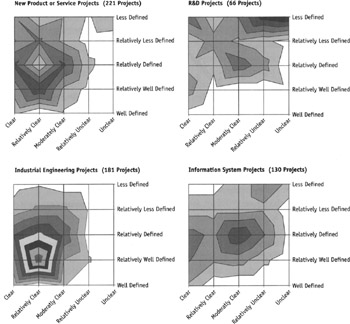Project Metrics
|
We have collected some basic information about the 1,621 projects performed by the respondents:
Project Duration
The global results indicate that 21.5 percent of the projects have an average duration less than six months, 51.5 percent with an average duration comprised between six months and two years, and 27.0 percent with an average duration over two years. According to the nature of the projects, it's not surprising to notice that infrastructure projects have the maximum duration (53 percent of projects over two years duration) followed by industrial engineering projects, information system projects, research and development (R&D) projects, and construction projects (respectively 34 percent, 34 percent, 33 percent, and 31 percent).
Project Budget
Seventy-two percent of the projects have a budget less than 50 billion French Francs (FF), 18.5 percent a budget comprised from 50 to 500 billion FF, and 9.5 percent with a budget exceeding 500 billion FF. The latter are better represented in infrastructure projects (28 percent), in industrial engineering projects (23 percent), in construction projects (18 percent), and in new product or service projects (13 percent).
Number of External Partners
The sample is divided into five categories according to the number of external partners involved in the projects: none, one to five, six to ten, eleven to thirty, and over thirty. The score obtained by each category gives respectively 14 percent, 42 percent, 15 percent, 15 percent, and 14 percent. The latter category can be found more easily in infrastructure projects (31 percent), construction projects (24 percent), industrial engineering (23 percent), evolutionary maintenance projects (22 percent), and information system projects (13 percent).
Degree of Innovation between Two Successive Projects of Same Nature
We introduce this variable because of its relative importance for many specific recommendations in project management contextualization. Four categories are distinguished: weak, mean, important, and unknown. The global average score for each category gives respectively 14 percent, 37 percent, 42 percent, and 7 percent. It is much more interesting to examine more precisely the results according to the nature of projects as shown in Figure 2.

Figure 2: Innovation Degree between Two Successive Projects
With this variable, the ranking is more original. R&D, quality, and training project participants consider that the innovation degree between two successive projects is important with respective scores of 65 percent, 58 percent, and 50 percent.
Life Cycle
We used a very traditional five-stage life cycle: initiation, design, execution, finalization, and closeout. We questioned the degree of relative importance (without defining criteria) they gave to each project phase. The average results show an interesting relation of proportionality between each phase, respectively 14 percent, 29 percent, 43 percent, and 14 percent!
More precisely, the initiation stage is considered more important for communication, training, organization and management, and closeout projects with respectively 19.7 percent, 17.5 percent, 16.7 percent, and 16.1 percent. For the design stage, events, training, new product and service, and R&D projects are more represented with a score quite equal to 32 percent. The execution stage is the kingdom of traditional external projects in construction, infrastructure, and industrial engineering (respectively 54.4 percent, 50.9 percent, and 50.2 percent) but also for quality projects (49.2 percent). Finally, it's not so amazing to notice the ranking of maintenance, informatics, and information system projects in the closeout phase which is often more problematic in such areas.
Turner and Cochrane's Project Typology
"Projects can be judged against two parameters: how well defined are the goals, and how well defined are the methods of achieving them", as Turner and Cochrane (1993, 93) suggested. We tried to give some statistical validation to this very suggestive typology. Every respondent was invited to map his projects on a goals-and-methods matrix directly on an exhibit included in the questionnaire. We represent on Figure 3 the results concerning four types of projects, considered by these authors to be the archetypes in each of the four sectors of their matrix (industrial engineering, new product or service, R&D, information systems). Our results show the validity of Turner and Cochrane's assumptions clearly for industrial engineering projects and for R&D projects. But it is less evident for product development projects and for information systems projects. The figure is conceived with a scale showing the relative density of the localization of the answers in proportion with the darkness of the areas, from the white one (0 to 2.5 percent) to the black one (more than 10 percent) with intermediate levels of gray every 2.5 percent more. Although we don't have enough space to show all the results for the different types of projects, we can confirm the discriminating power of the two variables used by Turner and Cochrane.

Figure 3: Goals-and-Methods Matrix
|
EAN: 2147483647
Pages: 207